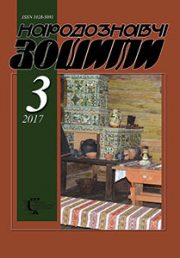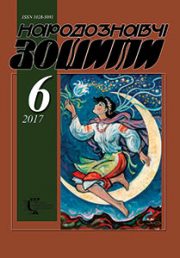The Ethnology Notebooks. 2025. № 5 (185), 1105—1114
UDK94(477.83):394.5:642.5″1991/1996″
PUBLIC CATERING AS AN ELEMENT OF THE EVERYDAY LIFE OF THE URBAN POPULATION: ESTABLISHMENTS IN LVIV AT THE BEGINNING OF THE 1990S
DYKYI Liubomyr
- ORCID ID: https://orcid.org/0009-0008-6095-0725
- PhD student,
- I. Krypiakevych Institute of Ukrainian Studies
- National Academy of Sciences of Ukraine,
- Department of Contemporary History,
- Kozelnytska str., 4, 79026, Lviv, Ukraine,
- Contacts: e-mail: lyubomyr.dykyi@gmail.com
Absytact. Introduction. Public catering, as an essential element of everyday urban life, offers a unique lens through which to explore the social and economic realities of Lviv in the early 1990s. In the wake of Ukraine’s independence, the city’s cafes, restaurants, and canteens became more than just places to eat; they served as meeting points, cultural spaces, and reflections of rapid societal transformation.
Problem statement. In the early 1990s, catering establishments in Lviv operated in conditions of economic instability and inflation. The city’s cafes, restaurants, and canteens served as meeting points, cultural spaces, and reflections of rapid societal transformation.
The purpose of the article is to study public catering establishments in Lviv in 1991—1996, highlight the typology, locations, cultural features and their role in the everyday life of Lviv residents.
Methods. General scientific methods of analysis and synthesis, as well as special scientific comparative-historical and chronological methods are used in the article. Significant attention is paid to the oral history method — interviewing eyewitnesses of the establishments — which helps to reconstruct everyday details and the atmosphere of the time. The author adheres to the principle of historicism.
Results. In general, in the first years of independence, cafes and restaurants that had been operating since Soviet times remained popular in Lviv. For example, ice cream cafes remained an affordable and familiar option for family outings, while young people often chose bars and coffee shops for first dates or meeting with friends. More popular restaurants continued to serve as venues for celebrating important occasions such as birthdays, weddings, and other milestones.
Conclusion. The old public catering network gradually passed into private ownership, changing both owners and concepts, which marked a slow but noticeable transformation of Lviv’s restaurant culture in the 1990s. New private establishments appeared in the city, offering original interiors, innovative service formats, and a wider variety of dishes.
Keywords: Lviv, Lviv residents, everyday life, public catering establishments, restaurants, food, urban culture, Ukraine’s independence restoration, post-Soviet transformation.
Received 30.08.2025
REFERENCES
- Heneha, R. (2019). The public catering system of the postwar Lviv: old and new practices. Ukrainian Historical Journal, 3, 49—73. DOI: https://doi.org/10.15407/uhj2019.03.049 [in Ukrainian].
- Shumylovych, B. (2013). Abandoning socialism: alternative spaces in Lviv in the 1970s—2000s. Ukraine: Cultural Heritage, National Identity, Statehood, 23, 602—614 [in Ukrainian].
- «Survive in the 1990s». Educational project. Center for Urban History of East Central Europe. Retrieved from: https://90s.lvivcenter.org/ (Last accessed: 30.07.2025) [in Ukrainian].
- Studnia, N. (2025). Coffee oases during the Soviet occupation of Lviv: where free thought flourished behind the Iron Curtain. Photographs of Old Lviv. Retrieved from: https://photo-lviv.in.ua/kavovi-oazysy-periodu-radianskoi-okupatsii-lvova-de-bylasia-vilna-dumka-za-zaliznoiu-zavisoiu/ (Last accessed: 25.07.2025) [in Ukrainian].
- Danyliv, N. (2015). What used to be located on the site of today’s «Puzata Khata»? Photographs of Old Lviv. Retrieved from: https://photo-lviv.in.ua/scho-kolys-znahodylos-na-mistsi-suchasnoji-puzatoji-haty/ (Last accessed: 26.07.2025) [in Ukrainian].
- Soroka, A. (2021). «Youth in the 1990s was not easy, but there is much to remember». Where in Lviv our parents strolled, danced, and drank coffee. This is Lviv. Retrieved from:https://inlviv.in.ua/lviv/molodist-u-90-h-bula-nelegka-ale-zgadaty-ye-shho-de-u-lvovi-gulyaly-tantsyuvaly-j-pyly-kavu-nashi-batky (Last accessed: 02.08.2025) [in Ukrainian].
- Pankevych, B. (2023). Taverns of Lviv in Soviet Times. Zbruch. Retrieved from: https://zbruc.eu/node/115330 (Last accessed: 25.07.2025) [in Ukrainian].
- Vynnychuk, Yu. (2016). Taverns of My Youth. Zbruch. Retrieved from: https://zbruc.eu/node/53616 (Last accessed: 25.07.2025) [in Ukrainian].
- (2019). Hlibovytskyi, & Pankevych — Coffeehouses. YouTube. Retrieved from: https://www.youtube.com/playlist?list=PLPRdslxAI9yeEcDjynEWnGRM2b616Hm6s (Last accessed: 08.08.2025) [in Ukrainian].
- (2018). Taverns of My Youth. Forum of Ukrainska Pravda. Retrieved from: https://forum.pravda.com.ua/index.php?topic=1015597.5 (Last accessed: 25.07.2025) [in Ukrainian].
- (2006). Restaurant review. Lviv Forum. Retrieved from: https://forum.lvivport.com/forums/restoranna-kritika.91 (Last accessed: 25.07.2025) [in Ukrainian].
- (2008). Shall We Nostalgize? Lviv Forum. Retrieved from: https://forum.lvivport.com/threads/ponostalguje mo.37882/ (Last accessed: 25.07.2025) [in Ukrainian].
- Lviv City Council Municipal Archive. F. 9. Op. 2. File 4465. Protocol of the 14th session of the 21st convocation of the Lviv City Council, January 29, 1993, decisions and related documents (Pp. 1—280) [in Ukrainian].
- Nemilych, H., & L. S. D. (1994, December 13). Lviv coffee or how to skip lectures. Moloda Halychyna, 144, 3 [in Ukrainian].
- Pl. Rynok, 34 — former Avenshtokivska townhouse. Center for Urban History. Lviv Interactive. Retrieved from: https://lia.lvivcenter.org/uk/objects/rynok-34/ (Last accessed: 25.07.2025) [in Ukrainian].
- Bakovych, R. (1994, July 11—17). Ambassadors dine at «Lux»! Expres, 25 (78), 4 [in Ukrainian].
- Balkovyi, B. (1992, January 30). On an empty stomach one thinks better. Moloda Halychyna, 10, 2 [in Ukrainian].
- Bakovych, R. (1994, July 25—31). Ukrainian variété — it is not striptease, but folk dances. Expres, 27 (80), 4 [in Ukrainian].
- Baliuk, N. (1993, May 22). Eh, variété, variété, variété… Vysokyi Zamok, 64 (131), 2 [in Ukrainian].
- Dykyi, L. (2025). Questionnaire about everyday life in Lviv (1991—1996). Lviv.
- Pension Fund of Ukraine. (2018, August 2). Indicators of the average monthly salary of employees engaged in the sectors of the national economy, 1992—2002. Retrieved from: https://www.pfu.gov.ua/70128-pokaznyky-serednomisyachnoyi-zarobitnoyi-platy-pratsivnykiv-zajnyatyh-u-galuzyah-natsionalnoyi-ekonomiky-za-1992-2002-roky-shho-zastosovuyutsya-pid-chas-pryznachennya-ta-pererahunku-pensij-vidpovidno/ (Last accessed: 27.07.2025) [in Ukrainian].
- Andrii. (2025, March 5). Life in Lviv in the early 1990s. Interview by Liubomyr Dykyi. Lviv [in Ukrainian].
- Café «Psiacha Buda». «Survive in the 1990s». Educational project. Center for Urban History of East Central Europe. Retrieved from: https://90s.lvivcenter.org/uk/places/?lo cid=90 (Last accessed: 30.07.2025) [in Ukrai nian].
- Hnatovskyi, B. (1996, September 21). If Only There Were Money and Good Food. Moloda Halychyna, (109), 3 [in Ukrainian].
- Masliy, M. (2025, February 3). Ihor Bilozir: «As if it were yesterday, dear mother, you were waking me up early…». Ukrainian-American Magazine. Retrieved from: https://ukrainianpeople.us/ігор-білозір-ніби-вчора-рідна-мамо-в/ (Last accessed: 08.08.2025) [in Ukrainian].
- Roman. (2025, March 5). Life in Lviv in the early 1990s. Interview by Liubomyr Dykyi. Lviv [in Ukrainian].
- Rostyslav. (2025, March 5). Life in Lviv in the early 1990s. Interview by Liubomyr Dykyi. Lviv [in Ukrainian].
- Baliuk, N. (1993, July 24). The «Lebid» doesn’t fly high. Vysokyi Zamok, 92 (209), 3 [in Ukrainian].
- Alkhimiky from «Sknylivka». (1995, July 13). Vysokyi Zamok, 94 (529), 2 [in Ukrainian].
- Horilka from «Kalynky». (1995, July 15). Vysokyi Zamok, 95—96 (530—531), 2 [in Ukrainian].
- Pavlyshyn, R. (1996, November 16—24). Felichita — it’s the joy of eating well. Expres, 44 (194), 12 [in Ukrainian].
- History. Artcenter «Dzyga». Retrieved from: https://dzyga.com/istoriya/ (Last accessed: 01.08.2025) [in Ukrainian].
- Cafй-galary «Dzyga». «Survive in the 1990s». Educatio nal project. Center for Urban History of East Central Europe. Retrieved from: https://90s.lvivcenter.org/uk/places/?locid=38 (Last accessed: 01.08.2025) [in Ukrainian].
- Belei, A. (2019, May 26). 20 photos of the iconic Lviv club «Lyalka» from the late 1990s. 032.ua. Site of the city of Lviv. Retrieved from:https://www.032.ua/news/2403410/20-svitlin-kultovogo-lvivskogo-klubu-lalka-kinca-90-h-rokiv (Last accessed: 30.07.2025) [in Ukrainian].
- Cabinet of Ministers of Ukraine. (1994, October 20). Resolution No. 727 on the amount of scholarship support for students, pupils, trainees of educational institutions, as well as postgraduate and doctoral students. Retrieved from:https://zakon.rada.gov.ua/laws/show/727-94-%D0%BF#Text (Last accessed: 27.07.2025) [in Ukrainian].
- Bodnar, N. (1995, February 25). Cecile Rochet: Lviv is a European city, but not Paris. Moloda Halychyna, 25, 2 [in Ukrainian].
- (2007). Restaurant review: Tavern «Za kulisamy». All of Lviv behind the scenes. Lviv forum. Retrieved from:https://forum.lvivport.com/threads/knajpa-za-kulisami-ves-lviv-za-kulisami.14923/ (Last accessed: 28.07.2025) [in Ukrainian].
- Vasiutyn, V. (1995, January 12—24). If you haven’t tried guksy, it will be hard for you to understand how it differs from pulgogi. Expres, 1—2, 3 [in Ukrainian].
- Café «Pingvin». «Survive in the 1990s». Educational project. Center for Urban History of East Central Europe. Retrieved from: https://90s.lvivcenter.org/uk/places/?locid=69 (Last accessed: 31.07.2025) [in Ukrainian].
- Prospect Tarasa Shevchenka, 24. Wikimapia Retrieved from: https://lia.lvivcenter.org/uk/objects/rynok-34/ (Last accessed: 05.08.2025) [in Ukrainian].
- Borutskyi, Yu. (1993, February 13). Titled cafe. Vysokyi Zamok, 20 (137), 1 [in Ukrainian].
- Kashytskyi Volodymyr — underground activist, plast member, philanthropist. History of Plast — 100 Steps — historical plast blog. Retrieved from: https://100krokiv.info/2017/03/kashytskyj-volodymyr-pidpilnyk-plastun-metsenat/ (Last accessed: 05.08.2025) [in Ukrainian].
- Who will become the owner of an enterprise, shop, cafe? (1993, June 17). Vysokyi Zamok, 76 (193), 2 [in Ukrainian].
- List of municipal property objects of the Lviv region subject to privatization. (1993, July 24). Vysokyi Zamok, 92 (209), 4 [in Ukrainian].
- B&B. (1996, January 24 — February 4). Another elite restaurant appeared in Lviv. Expres, 3 (153), 4 [in Ukrainian].







